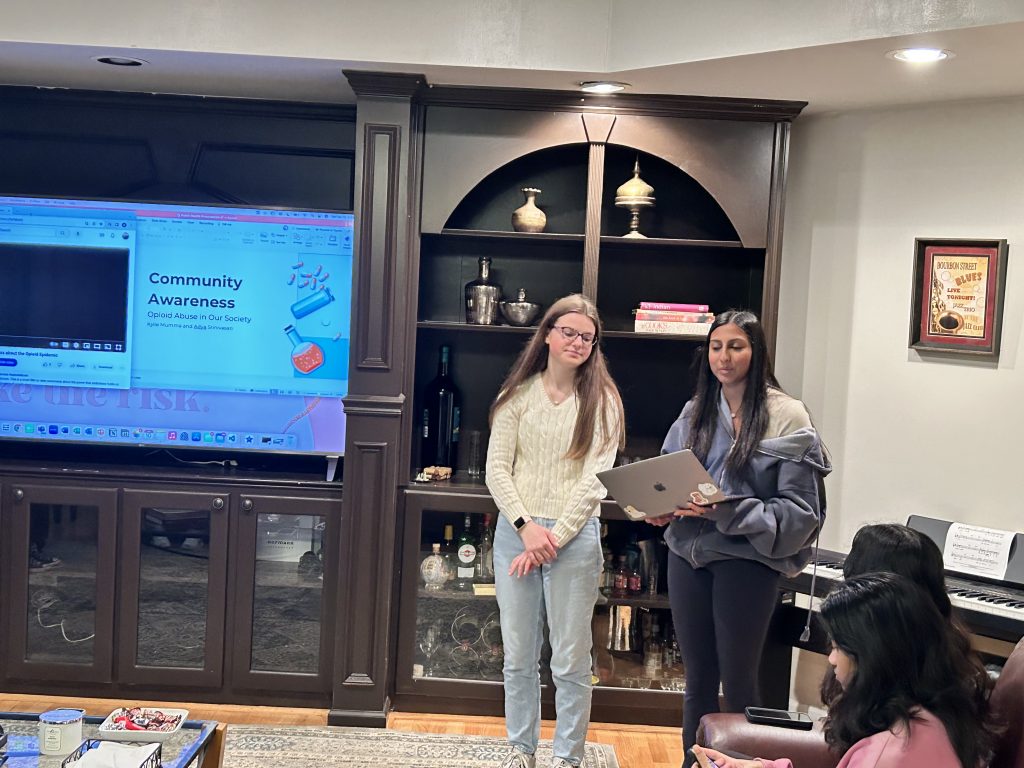At the recent State Leadership Conference for HOSA (Health Occupations Students of America), Kylie Mumma and Adya Srinivasan showcased their outstanding community awareness campaign targeting opioid abuse. Their efforts were not only applauded but also rewarded as their campaign won at the state level, placing 2nd in the state for community awareness. Their project will take them to the international conference in Houston, Texas June 26th-29th and we wish them the best of luck!
Their dedication serves as an inspiration to us all, reminding us of the power of advocacy and the difference that passionate individuals can make in the world and they are working to reach even more people and communities with their message.
Congratulations to Kylie and Adya on their well-deserved recognition and hard work. We are proudly sharing their campaign below.
The Importance of Opioid Abuse Awareness
Adya Srinivasan and Kylie Mumma
Why is it important?
Approximately 3 million people in the U.S. have a current opioid use disorder or they had one previously, and nearly 10.2% of adults in the U.S. have misused pain medications. Also, more than 75% of drug overdose deaths in the U.S. in 2021 was due to opioids.
What is Opioid Abuse?
Opioids are chemicals that interact with opioid receptors in the body and brain to reduce the perception of pain by producing feelings of euphoria, which make it significantly more likely that people will feel an urge to continue using them. Opioid use disorder is defined as a chronic disorder with serious consequences, which include disability, relapses, and even death.
What are the symptoms of Opioid Abuse?
- Using a larger dosage of drugs or taking them longer than needed.
- Unsuccessful efforts to control opioid use.
- A strong sensation or urge to continue using opioids.
- Problems fulfilling obligations at work, school, or home.
- Continued opioid usage despite any social problems or giving up activities due to opioid usage.
- Using opioids in dangerous situations, including when driving.
- Continued opioid usage regardless of physical or psychological problems that could have been caused or worsened by the opioids.
- Need for a higher dosage of opioids due to a tolerance of the effects.
- Experiencing withdrawal when attempting to quit or taking opioids to relieve any withdrawal symptoms.
What is the treatment?
There are three medications that are approved by the FDA that are typically given to prevent withdrawal symptoms, which include Methadone, Buprenorphine, and Naltrexone. Treatment will typically encompass some cognitive behavioral approaches and participation in Narcotics Anonymous. The level of treatment may be different depending on each patient, but it can range from outpatient counselling to long-term therapeutic communities.
How can we prevent it?
It is recommended that people in need of pain medications talk with their healthcare provider about other options that do not include opioids. Naloxone administration is also used to quickly reverse the effects of an overdose. It comes in the form of an injection or a nasal spray, and it is safe to use and will not harm a person even if administered to someone that is not experiencing an overdose.
Resources
American Psychiatric Association
Centers for Disease Control and Prevention
The Effect of Opioid Abuse: A Pharmacist Perspective
Adya Srinivasan and Kylie Mumma
We interviewed CVS director, Nikhil Patel, to gain insight from a pharmacist about the impact of the current opioid epidemic in the U.S. and ways we can mitigate this issue. Here are his responses to the questions we asked.
1. Do you feel that Opioid abuse is a significant issue affecting our community and teenagers today?
“Opioid abuse is a very significant issue affecting our communities, especially teenagers today. The number of people who have died from a drug overdose has increased over 16% from 2020 to 2021, and of those, more than 75% involved an opioid.”
2. How do you feel that Opioid abuse impacts our community? Have you seen any instances of Opioid abuse occurring around you or do you know someone who has been impacted?
“The opioid epidemic has been devastating families and communities for years, and also has a large financial burden to the economy when you include the impact on families, the health care system, and communities. Not long ago in 2016, we lost more than 115 Americans to opioid overdose deaths every day.
Several years ago, I met with a lady who lost a son at the age of 16 due to misuse of prescription pain medications. The impact on this mother and her family is still felt every day even 10 years after her son passed away. And the worst part about this situation is that the pain medication the son was abusing belonged to the mother. She had no idea he was stealing them and abusing them.”
3. What do you think should be done to mitigate this issue? Is there anything people in the community should be doing to raise more awareness and prevent this issue from occurring? Is there anything you think teenagers should know about Opioid abuse?
“In order to help stop the opioid epidemic, we need to take several steps:
1. Limit the inappropriate use of prescription steroids
2. Make sure that teenagers and adults are both aware of the abusive and addictive potential of opioid medications
3. Drug take back programs to help remove opioid medications from the community when someone does not need them anymore
I think one important thing teenagers should know about Opioids is that just because they are prescribed by a physician does not mean they are safe to take without being under the care of a healthcare provider.”


